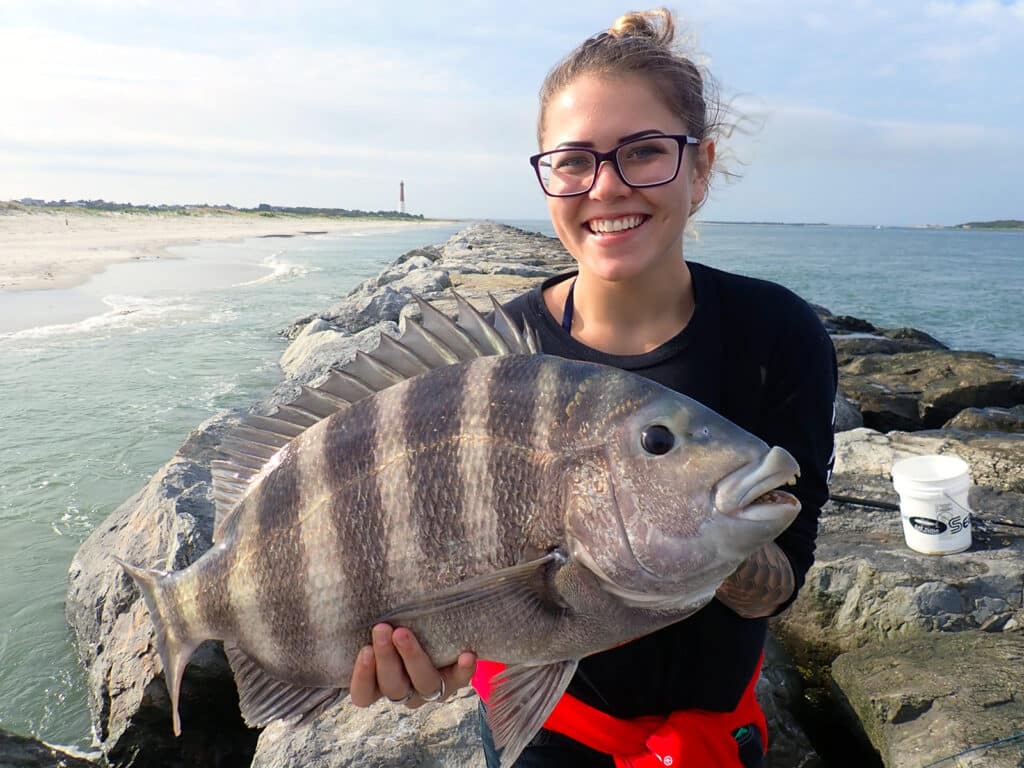
Bob Misak tread precariously along the slippery, moss-laden boulders of Barnegat Inlet’s south jetty. He had a rod in hand and bucket of Asian crabs tied along his waist. Though Misak is a good friend, I didn’t worry about him slipping into the drink. I was more focused on the spot where he stopped.
“This is it,” he said. “The rock where they hang.”
In New Jersey, you’d think he was stalking stripers or blackfish. But he was referring to sheepshead, the unicorn, structure-loving beast of Garden State waters. Misak dropped his rig down, gave the rod a light tickle, then a booming strike buckled his rod. With rod in one hand and net in the other, Misak reached down and nabbed a 12-pound sheepshead. Misak shot me a glance as he released the “jail breaker.”
New Jersey’s Sheepshead History
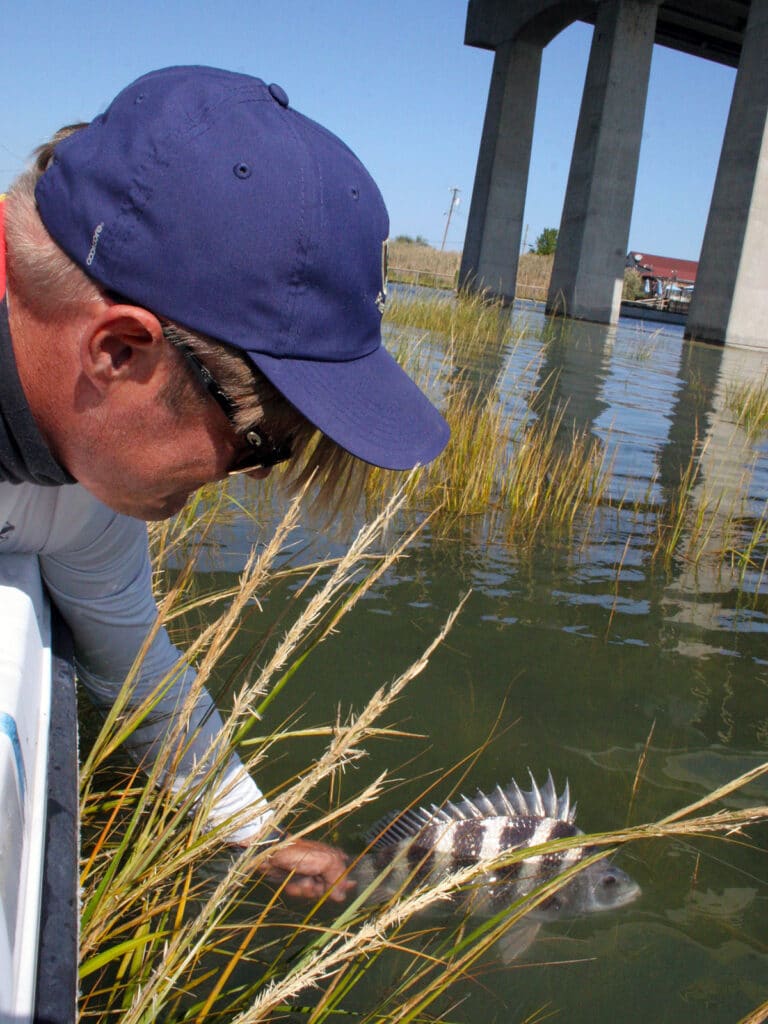
I can hear anglers in the south saying: “Sheepshead, what’s the big deal?” I’ll tell you. Sheepshead aren’t a normal species in Jersey. Let me back up, they haven’t been normal in Jersey for at least 40 years. Historically, their convict-striped presence was once common in New York and New Jersey. Sheepshead Bay off of Long Island, New York, got its name for a reason.
Also, any sheeps caught in Jersey rarely fall below the 5-pound mark, with average catches weighing between 8 and 14 pounds. The state record caught in 2014 stands at 19 pounds, 3 ounces. Whether due to warming climate, an invasion of Asian shore crabs in the 1980s, or something else entirely, a trophy sheepshead fishery has been available in New Jersey for the past 15 years. Anglers are becoming hip to the secret.
Jockeying for Sheepshead on Jetties
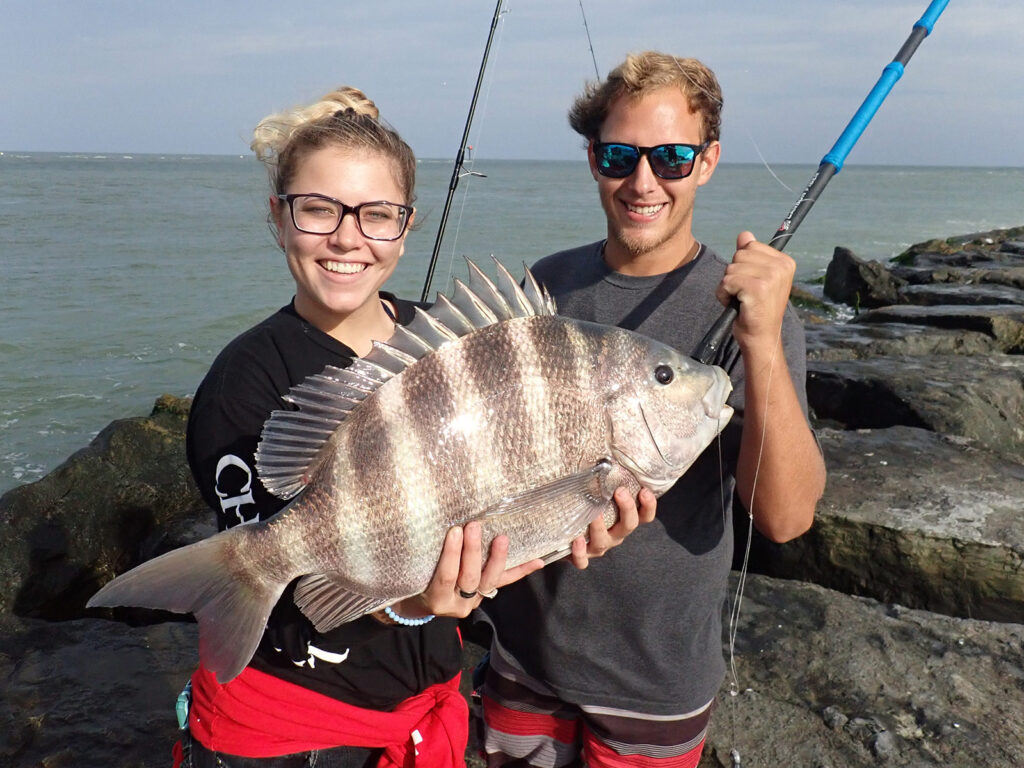
Misak’s land-based sheepshead exploits have made him a shore legend in the Garden State — his top sheepshead catch of 15.4 pounds would’ve broken the state record. But he didn’t know at the time and put it in the frying pan.
“I know some divers that key me in on where they stack up in schools of 4 to 6 fish of the same size,” said Misak. “They tend to stay on the same rocks, year after year in the same area.” On one outing, Misak and his friend bested six fish that all weighed between 14 and 15 pounds.
“You won’t find sheepshead on wrecks off the shore, but in back bays or at inlet jetties where waters are as deep as 25 to 30 feet,” he said. “There needs to be clean water, structure, and lots of tidal flow. Ideal water temperatures bounce between 70 and 78 degrees. You want to fish the outgoing tide along the jetty rocks.”
Misak’s jetty rig consists of a 7-foot, 6-inch medium-heavy rod, 3500 Shimano Stradic, 50-pound braid, and 40-pound, 24-inch dropper loop rig. Three inches separate size 3/0 Gamakatsu Octopus hooks on the bottom rig. A 1.5- to 3-ounce bank sinker keeps the rig on the bottom. He hooks small quarter-size crabs through the bottom pad.
“They hit hard on the run, moving like a big blackfish running along the bottom,” explained Misak. “Once their body is sideways, then the fight is on. Let the drag do the work and steer away from the rocks until they tire out. I’m finding that it’s possible we may be seeing a new migratory pattern — their sizes are going down to 10 pounds and lower with people beginning to target them more often.”
How to Fish Bridge Structure for Sheepshead
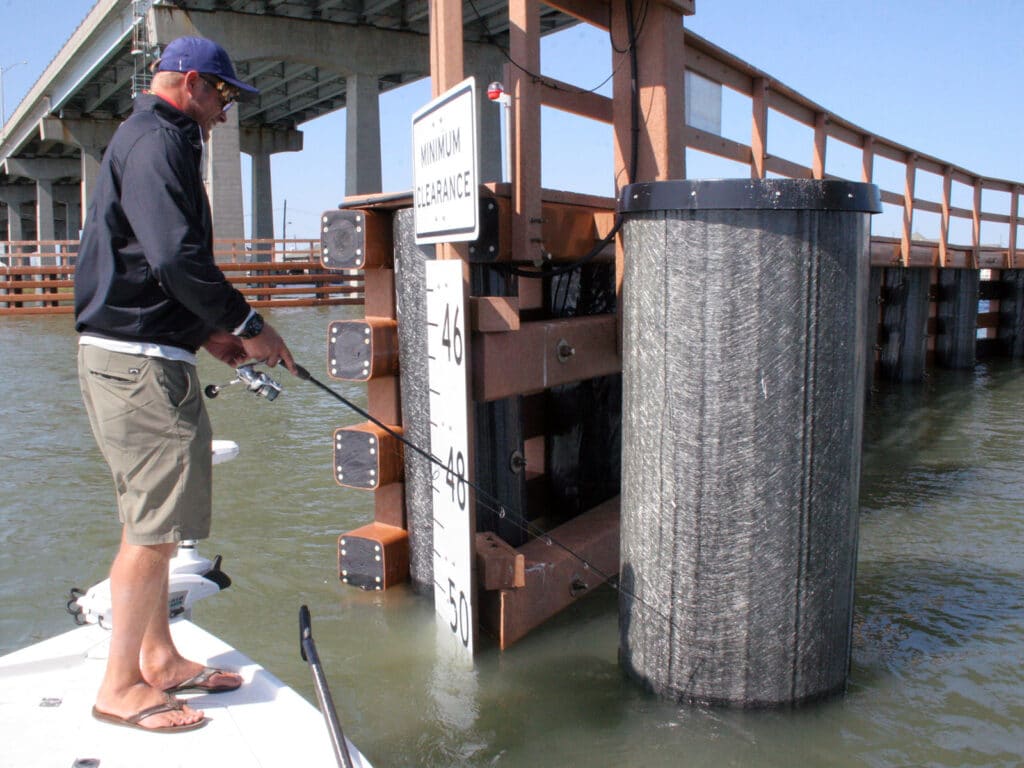
Anyone in the tristate area knows the name Capt. Dan Schafer, of Insomniac Guide Service, is synonymous with Jersey sheepshead. He has always been a forerunner, targeting south Jersey sheepshead.
“I found them while tautog fishing on the south Jersey bridges in 2005, where I put an underwater camera down and saw a school of sheepshead,” said Schafer. “After that, I dedicated myself to fishing for them where I landed my first, an 8-pounder, on a regular one-hook dropper rig. I noticed that even though sheepshead stay around structure like blackfish, they don’t react or stage like blackfish do.”
Schafer then learned their yearly habits.
“Usually, the season for Jersey sheepshead in the back bays is late May to October,” he explained. “Sheepshead show up when waters hit 57 degrees, and up to 75 degrees, staying throughout the summer and into the fall. Big sheepshead hang on the front side of bridge pilings and icebreakers as they will be the first to grab crabs funneling by, while the other smaller fish hang on the leeward side of the structure to get the rest of the crabs.”
Schafer fishes the lightest tackle jig possible to give a natural presentation in the current, with speed dictating what exact ounce. Generally, bottom-sweeper jigs from ¼- to 5/8-ounce suffice. When waters are dirty, bright colors like chartreuse or pink work better. When waters are clear, white or unpainted heads work best.
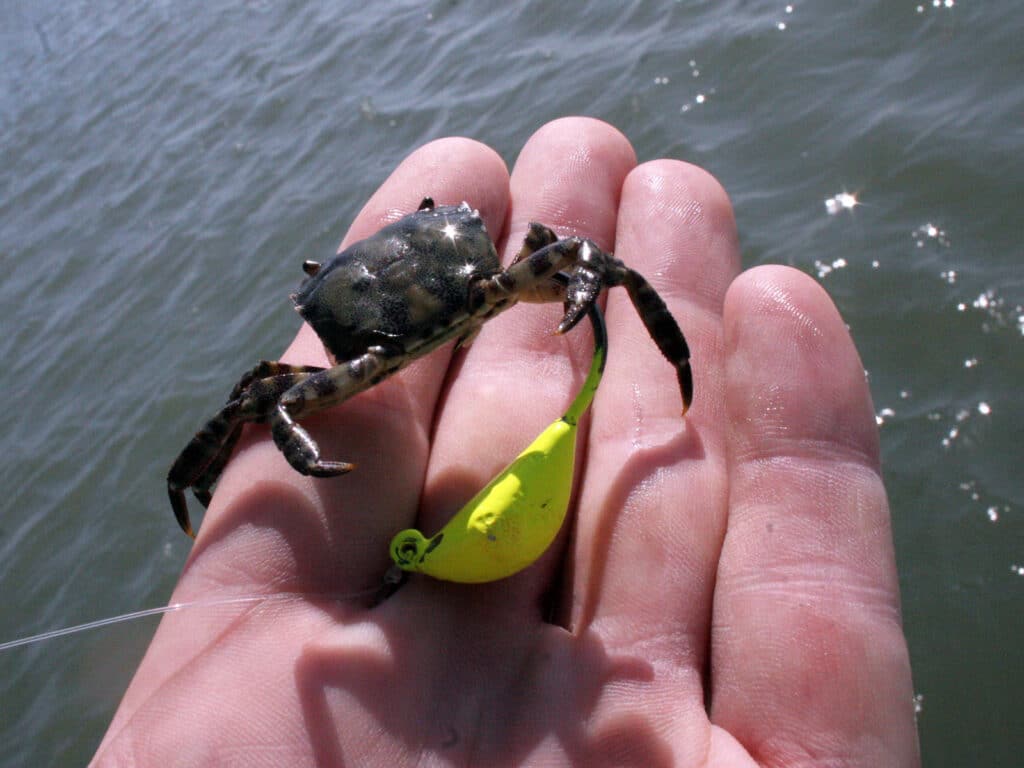
Proper bait choice is a major factor in success rates.
“Asian crabs are spring and fall baits, while fiddler crabs are summer baits (from mid June to August),” Schafer. “Sheepshead are hanging shallower in the water column off structure, like 1 to 6 feet down. Crab hatches are flowing with the tides, up in the water column. On the full and new moons, the fish feed accordingly.”
Water clarity also plays a large part on strategy, according to Schafer.
“The more stained the water, the shallower or more vertical in the water column they are,” he said. “Cleaner water they stage deeper. In the faster the current, the higher in the water column they feed. While during the more slack tides, the lower in column they’ll hang. Sheeps are aggressive feeders, not like tautog, hanging on the bottom but will come up and roam.”
Schafer’s technique is kind of odd, but it’s directed. “I’ll work the bridges, spot-locking right and tight on a piece.”
Many times, Schafer is literally holding the icebreaker or bridge piling with his hands. “I’ll dip a jig baited with crab starting two feet down, then if there isn’t a bite, drop it two more feet, and repeat that process until I hit bottom down to 30 feet. If I don’t get a hit after three tries on that spot, I’ll move to another piece. It could be 20 feet away, but it makes all the difference.”
Slack tide doesn’t mean the fish won’t feed. “When the tide starts slacking, they will come off structure, even 30 feet off a bridge to roam around,” said Schafer. “Toss around a jig at slack and work it back; I’ve landed fish to 10 pounds on the slack, fan-casting off the structure. Best baits are calico sand crabs, as they are the more natural baits away from the structure.”
Sod Banks for Sheepshead
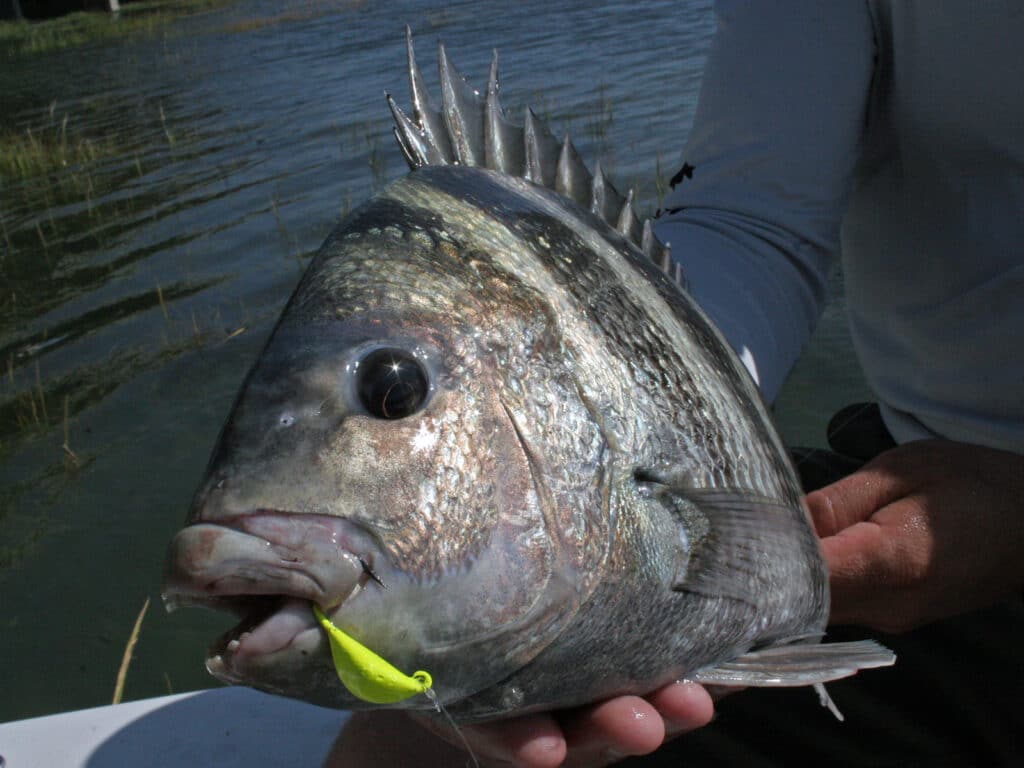
Hard structure is one facet, but soft structure along the sod banks can be just as productive.
“Sodbank fishing with light jigs and light tackle is critical to not getting hung up,” said Schafer. “Sod banks erode on one side with steep relief; the sweet spot is 10 to 16 feet dropping to 22 feet along the ledges and steps of the submerged sod. They will stay around the submerged root system to forage. Drop to the bottom and walk a jig back over the sod, finding those deep holes. Crawl it back and inch it little by little, not jigging, but inching it back getting into the holes and ledges of the submerged sod.”
When battling trophy sheepshead from the boat, they earn the name “jail breaker” as they will shake hooks like mad to escape.
“Sheepshead aren’t vertical fighters, but horizontal,” said Schafer. “They’ll use their flattish porgy body design in the tide to plane with the water for leverage, not like blackfish that dog down. When hooked up, I back up the boat to pull them away from the structure with a light smooth drag. Then you can fight them as they plane up to the surface.”
Jersey sheepshead are quickly becoming a new species on the hit list, not simply because they are a relative anomaly in the waters, but for their great fighting power and dependable size. Is the new world-record sheepshead going to be taken from Jersey’s relatively untapped waters? I wouldn’t bet against it.
Sheepshead Fishing Tackle
- Rod: 7 to 7.5-foot medium to heavy stout spinning rod
- Reel: 3000 to 5000 spinning reel
- Line: 14- to 30-pound braid running line; 30- to 40-pound fluorocarbon leader
- Lures: ¼- to 1-ounce bottom sweeper jig in chartreuse, pink or white
- Bait: Asian crabs, sand fleas, fiddler crabs, Jonah crabs and calico crabs








